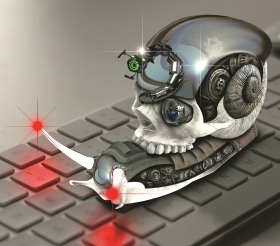

While there is seemingly endless news about artificial intelligence (AI) and how it’s going to change the world, the surveillance industry finds itself in a situation where AI, and more specifically, its deep learning (DL) discipline, has the potential to deliver real benefits in the world of video analytics.
But it’s easy to talk about DL and AI; understanding exactly what it is and what it can bring to the surveillance world is another question altogether. Before AI became a buzzword, video analytics applications were already identifying objects and raising the alarm when something went askew, so what will all this new, complicated stuff add that will benefit the customer looking for better security at the end of the day?
IHS-Markit noted that security cameras with video analytics capabilities accounted for 17 million shipments in 2017; this is forecast to rise to over 70 million shipments by 2022. The number of recorders with video analytics capabilities is also expected to grow until 2022, by a factor of 5 according to IHS-Markit. We will therefore see a much higher reliance on analytics in the near future, which will only benefit customers if the analytics is improved because of AI.
Hi-Tech Security Solutions asked a few companies that are making use of AI and all its sub-categories to educate us about AI and its current and/or future impact. We received input from the following:
• Andrew Mu, product manager at Hikvision South Africa.
• Janis Le Roux, Africa marketing manager at Dahua Technology South Africa.
• Josua Braun, senior product marketing manager at Dallmeier.
• Vanessa Tyne, senior KAM and team lead at Axis Communications.
Hi-Tech Security Solutions: Will the implementation of AI and DL in video analytics have a large impact on the accuracy of video analytics and a subsequent reduction in false alarms?
Andrew Mu: Artificial intelligence and deep learning have showed greater capabilities than humans in some areas, including video and image analytics. Their ability to enhance the recognition of human beings – distinguishing them from animals, for example – makes video analytics more accurate and subsequently helps reduce false alarms.
Hikvision’s deep learning technology can help distinguish people and vehicles from other moving targets – such as raindrops, animals, or changes in lighting that would result in false alarms – and takes alarm accuracy to a significantly new level. This cutting-edge false alarm reduction function can be found in a multitude of Hikvision product lines now, including its DeepinView and DeepinMind series, Turbo HD and EasyIP families as well as thermal cameras, to meet different industrial requirements.

Janis Le Roux: Deep learning technology is an important technical direction of AI. Through the continuous training process of data, the performance of the algorithm is continuously improved, especially the analysis ability of the target, so that the characteristics and attributes of the target can be analysed more accurately. In the video surveillance field, AI algorithms still have a lot of room for improvement, however, Dahua is committed to providing the high-quality artificial intelligence capabilities for various application scenarios.

Josua Braun: Deep learning algorithms and the introduction of AI in video analytics in general improve its accuracy by quite a factor. For perimeter protection, for example, Dallmeier already offers solutions in which customers can reduce the number of false alarms to almost zero. Nevertheless, it is generally true that AI-based systems can only be assistance systems that support the operator, not replace his or her actual powers of observation.
With ‘unusual behaviour’ detection we should be very careful. Systems can detect conspicuous behaviour of objects – people or things – under ideal conditions. However, many general conditions are still completely unclear. What happens, for example, if a conspicuous behaviour is not detected? Who is called to account if this happens? Which expectations are awakened and then have to be implemented politically if necessary? What happens if people manipulate these systems?

Vanessa Tyne: With the implementation of AI and the use of analytics, we will definitely see a reduction in false alarms as AI allows for the learning of an environment and what is usual versus unusual behaviour. We have already seen great strides in the learning capabilities of AI, and how it is already detecting an incident of an object left behind, or placed in an area that does not normally have this item there. In terms of behavioural analytics, AI can already decipher the difference of what is usual or unusual – so falling in an environment or loitering can be observed and deemed unusual.
Hi-Tech Security Solutions: Is the expectation of proactive or predictive analytics that will take stored and real video data and deliver predictions that can prevent crime or other unwanted activities realistic?
Andrew Mu: Yes. For example, the most traditional perimeter protection systems use active infrared detection (IR). But traditional IR sometimes cannot make accurate predictions, and, lacking video data, it can be rather difficult to locate key alarm points.
Hikvision has introduced the Turbo HD PIR camera that improves alarm accuracy and prevents intrusions. When an intrusion occurs, it can issue an alarm immediately and produce a flashing white strobe light that serves as a warning signal to stop intruders. In some cases, intruders will be deterred and leave – thus crime can be prevented, not just detected.
Janis Le Roux: Crime prevention is a comprehensive issue that focuses on how to improve management capabilities, including human management and skills management. Technology has become a basic and core competence to improve management efficiency and quality. Dahua Technology combines management methods and technology in its security solutions, and carries out the upgrading from post-tracking to pre-prevention, and practices how to prevent crime from the perspective of comprehensive governance.
Vanessa Tyne: I believe that we will never be able to precisely predict that there will be a crime taking place at this very moment; however, systems are becoming a lot more sophisticated in their ability to assist in identifying possible unwanted activities and unusual behaviour within a person or group of people.
Hi-Tech Security Solutions: How will surveillance solutions overcome the need for vastly increased processing power AI requires? Will we see back-end servers growing even larger and more powerful, or will we see AI processing offset to the camera on the edge?
Andrew Mu: Hikvision believes that a distributed structure is the right model for AI processing in surveillance solutions. The technological architecture of the Hikvision AI Cloud system consists of three parts:
• Edge node: Data collection from multi-dimensional sensors and front-end processing.
• Edge domain: Intelligent applications for data collection, storage and processing.
• Cloud centre: The fusion of business data, and the applications of multi-dimensional big data analysis.
With the distributed structure, it won’t be necessary to transmit all data to the cloud centre for processing, which means parts of data processing will be done in the edge node or edge domain.
Janis Le Roux: Dahua Technology has always emphasised what it terms ‘Full Computing’, taking advantage of the respective capabilities of cloud computing and edge computing, and deploying computing power based on the application scenarios and solutions for the business and the overall situation of the entire network. Dahua has released a variety of hybrid computing power AI solutions, and has competitiveness in both edge computing and cloud computing products.
Josua Braun: AI-based classification requires a lot of computing power. This will not change in a revolutionary way in the foreseeable future. In detail, there are already many differences today. For example, it is something completely different whether one has to observe a situation with comparatively few objects (e.g. a perimeter situation, a port or places with little traffic) or situations with many objects (e.g. stands in a football stadium).
Depending on the application scenario, different techniques are already being used today. In addition, modern video sensor technology already enables AI-based prequalification within the camera, so that significantly less data is evaluated by a central server. This is basically a classic case of edge computing.
Vanessa Tyne: The reality is that processing on the cameras will need to become more powerful to allow for the analytical processing to take place on the camera before sending the alarm/notification through to the VMS. New technology like our ARTPEC 7 chip is powerful enough to enable AI on the edge. It will also allow for some deep learning mechanisms, and with the partnership of DL partners, we foresee this as a reality that is already happening.
Hi-Tech Security Solutions: Alternatively, will cloud technologies be used for AI-related processing with only the results or outcomes sent to or kept on site, or some similar model?
Andrew Mu: This is similar to the question above. Hikvision AI Cloud is a three-layered architecture that incorporates cloud and edge computing to provide multi-dimensional perception and front-end processing at edge nodes, and then process data in real time and send the processed data to edge domains for intelligent applications and to create new data, and further converges on-demand data to the cloud centre for big data analysis. AI related processing and storage will occur in both the centre and edge, forming a complete AI cloud system. This model is more efficient and data will only be processed and stored in necessary places.
Janis Le Roux: In the field of AI, cloud computing is more suitable for massive data processing and application management, such as data retrieval, data collision across time and space. In practical applications, usually a single scene or single-point video cannot analyse the whole picture of the event, and it requires collaborative analysis of multi-dimensional data, and even collaborative data analysis across a long period of time, which needs to be realised by cloud computing.
Josua Braun: Cloud computing will certainly play an important role here in the future, and as a manufacturer we are also intensively dealing with this topic. In general, however, we do not yet consider the use of the cloud to be central in the B2B (business-to-business) area, i.e., where high data volumes of high-resolution recordings are involved, due to the cost of storage and the high transfer rates required. But we see an important topic here in the future.
Vanessa Tyne: Looking at where the industry is going from an IT perspective, we can see that IoT and cloud computing is becoming more prominent. So yes, having a cloud-based AI platform will lessen the cost for the customer, but ensuring that the correct infrastructure is in place to handle all the data that will be sent will be critical for it to work as intended.
We also need to consider the POPI Act and GDPR Act regarding personal information and how it is being used and what it is being used for.
Hi-Tech Security Solutions: What will happen to those focused on open standards when proprietary AI software limits your opportunities?
Janis Le Roux: AI could be a powerful tool to help us complete a lot of professional work, which reduces labour intensity and improves productivity. However, AI is in a rapid development stage, which requires us to set standards for such emerging technologies. Especially now, when the current AI is in full bloom, the technologies and services provided by each company are quite different, and it is necessary to ensure the healthy development of technology and the industry through standardisation and promotion. As a video-centric smart IoT solution and service provider, Dahua Technology is actively participating in the development of industry standards in the field of AI.
Josua Braun: The trend in IT and also in high-end video technology is clearly towards platform solutions. AI will also have to fit into this context. Moreover, it is usually a matter of further processing of the analysed results in a system. So, if the analysis system itself is proprietary, but the data it generates can be universally processed, we don’t see any problem here.
Vanessa Tyne: Simply, looking at a closed solution will limit the customer. Having the ability to move forward with technology is key and a critical benefit to the customer.
Hi-Tech Security Solutions: What are you doing to enhance the analytics in your systems? What enhanced benefits will your customers be able to experience due to improved analytics enhanced by AI?
Andrew Mu: Hikvision is developing our trustworthy AI system with deep learning algorithms. Enhanced accuracy is the result of multi-layer learning and extensive data collection. Application of this algorithm will significantly advance the performance of video analytics.
Some examples of added benefits include using the latest technologies to replace the large amount of manpower previously required for searching surveillance footage, detecting anomalous data, and finding ever-more efficient ways to allow surveillance to shift from post-incident tracing to alerts during incidents – or even pre-incident alerts. The emergence of deep learning has enabled these demands to become reality.
Technologies incorporated into the Hikvision portfolio include:
Vehicle identification, which can be used to identify vehicle number plates, and recognise different types of vehicles (even down to the make and model), or to trigger alerts when vehicles enter restricted areas.
Perimeter protection, which helps organisations to identify real threats by distinguishing people and vehicles from other moving objects and keeping false alarms to a minimum.
Business intelligence, which employs people counting, queue detection, and heat mapping technologies, so that organisations can enhance operational efficiency by making use of the data.
Janis Le Roux: The current AI products and solutions from Dahua are helping our customers improve their efficiency and the quality of information management, as well as reduce operating costs. We are also in the process of communication with customers on how to further help improve their management capabilities. This is also the inevitable trend of data-driven industrial upgrading in the future.
Josua Braun: One point is essential which, in our opinion, is discussed far too rarely: AI follows the principle of ‘Garbage In, Garbage Out’. This means that a video-based analysis or object classification can only be as good as the video image to be analysed. So, before we think about AI software, etc., we should first of all consider the quality of the camera systems involved.
And here planning procedures are particularly important: Can I plan a video installation in such a way that I can predict exactly what image quality I will get for each area? When I think about a combination of PTZ and megapixel cameras, am I aware that I can only achieve a high image quality in those areas that I record with the PTZ camera, but that the rest of the image may have poor image quality and thus poor analysis results? What image quality do I achieve with my cameras at all?
As far as the second part of the question is concerned, from our point of view there are few systems from which one can extract information from complex situations as easily as a camera image. Used as a ‘smart optical data sensor’, we see a great future for camera-based data capturing and a high customer benefit for an ultimately unlimited number of applications.
Specifically, we offer AI-based solutions for dramatically reducing false alarms in perimeter protection, for people counting in complex contexts, or generally for detecting objects of different types in order to record counting data or inform other systems accordingly. This data can then be used by our customers to improve security, optimise their human resources and improve business processes.
Vanessa Tyne: We understand where technology is heading and we are building and deploying systems and technology that will give the customer peace of mind knowing that the accuracy of analytics is improving and becoming less dependent on massive compute power.
For more information contact:
• Axis Communications, +27 11 548 6780, [email protected], www.axis.com
• Dahua Technology South Africa, Marius du Preez, +27 66 230 2684, [email protected], www.dahuasecurity.com
• Dallmeier Southern Africa Office, +27 11 510 0505, [email protected], www.dallmeier.com
• Hikvision South Africa, +27 87 701 8113, [email protected], www.hikvision.com
| Tel: | +27 11 548 6780 |
| Email: | [email protected] |
| www: | www.axis.com |
| Articles: | More information and articles about Axis Communications SA |
| Tel: | +49 941 8700 111 |
| Email: | [email protected] |
| www: | www.dallmeier.com |
| Articles: | More information and articles about Dallmeier Electronic Southern Africa |
| Tel: | +27 10 085 8300 |
| Email: | [email protected] |
| www: | www.hikvision.com/africa/ |
| Articles: | More information and articles about Hikvision South Africa |
| Tel: | +27 11 543 5800 |
| Email: | [email protected] |
| www: | www.technews.co.za |
| Articles: | More information and articles about Technews Publishing |
| Tel: | +27 10 593 3242 |
| Email: | [email protected] |
| www: | www.dahuasecurity.com/sa |
| Articles: | More information and articles about Dahua Technology South Africa |

© Technews Publishing (Pty) Ltd. | All Rights Reserved.